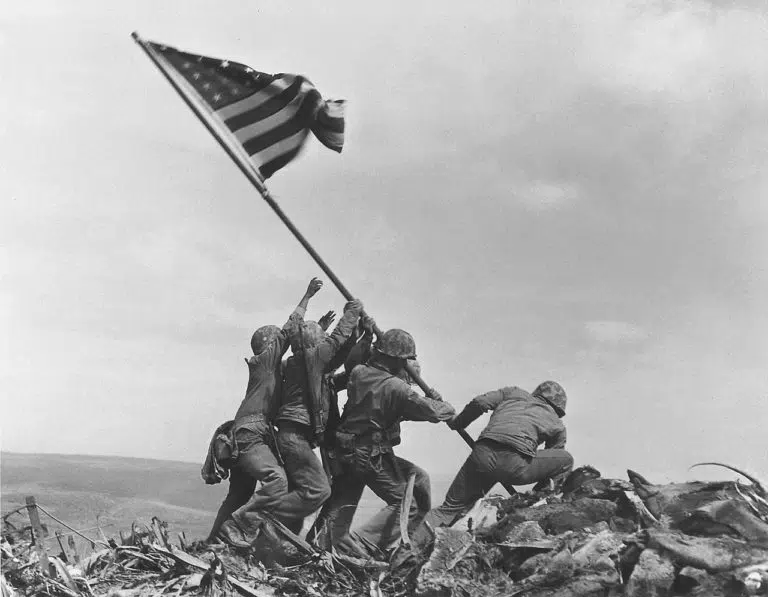On November 10, 1775, the Second Continental Congress passed a resolution creating two battalions of Marines. These new “Continental Marines” signed on to serve as landing forces for the colonial fleet.
And serve they did. One of their most important duties was to provide security on naval vessels, which sometimes required a daring approach. During naval battles, for example, Marine sharpshooters would climb to the fighting tops of the ships’ masts, so they could fire down on enemy soldiers who were aiming at continental officers, gunners, and helmsmen.
Today, the U.S. Marine Corps is famous for its amphibious operations. This expertise is not recent; it dates to the very beginning of the service, when Continental Marines carried out this country’s first wartime amphibious landing. During the Revolutionary War, as part of the colonial force at the Battle of Nassau, Marines landed in the Bahamas and seized England’s Fort Montagu, capturing a large store of gunpowder and munitions.
New Name, Same Mission

After the Revolutionary War, the Continental Marines disbanded. But after a hiatus of fifteen years, President John Adams signed into law a congressional act that created the United States Marine Corps.
The Marines have played a crucial role in America’s defense ever since, fighting pirates in the early 1800s and even participating in the Civil War. In World War I, Marines fought in some of the toughest engagements of that conflict. For example, in the Battle of Belleau Wood, thousands of Marines engaged in 20 days of intense combat armed with little more than bayonets. Unwilling to give up, they eventually overcame their German opponents, who gave the Marines the now-famous nickname of “Devil Dogs.”
In World War II, the Marines played a central role in the Pacific conflict and were active in every major battle in that theater. Photographer Joe Rosenthal memorialized their bravery and tenacity with his iconic photo of five Marines and a naval corpsman raising the U.S. flag at Iwo Jima.
Since then, the Marines have fought in every major U.S. military engagement. But Marines also serve during peacetime, and today they are well-known for providing humanitarian aid during times of crisis.
A History of Helping
For decades, Marines have rendered aid both here in the U.S. and abroad, proving that they are just as effective at lending a hand as they are in battle.
In California, Marines have fought fires and provided earthquake relief for fifty years. In states as diverse as Florida, South Carolina, and Hawaii, the Marine Corps has mounted rescue and relief operations after severe hurricanes knocked out critical infrastructure. When Hurricane Katrina hit Louisiana, Marines left the safety of their base to rescue civilians, fighting through gale-force winds and blinding rain to bring people to safety. And after Hurricane Maria devastated Puerto Rico in 2017, the Marines conducted search and rescue operations, then set to work restoring the island’s infrastructure and bringing in food and medicine.
In addition to helping at home, the Marine Corps has provided humanitarian aid across the globe. They’ve delivered supplies and offered medical assistance after tsunamis and cyclones in Bangladesh, Indonesia, and Mozambique. In 2010, when a deadly earthquake struck Haiti, 2,000 Marines arrived to help the island nation feed and care for its people. And the Marines have returned every year since, providing medical, dental, and engineering assistance.
As in war, the Marines are among the first on the ground after a calamity, providing aid, clearing roads, and restoring water, electricity, and other utilities. In 2011, right after Japan was hit by a massive tsunami, Marines arrived at the Sendai airport, where they cleared hundreds of smashed vehicles to reopen the runways. And when Nepal experienced a severe earthquake in 2015, Marine Corps helicopters delivered some of the first supplies to remote Himalayan villages
A Tradition of Celebration
The US Marine Corps began celebrating November 10 as its official birthday in 1921. Many of the most recognizable traditions started a few decades later, in 1952, under the leadership of Commandant Lemuel C. Shepherd, Jr. Now, every year on November 10, Marines gather across the country and throughout the world to celebrate the founding of the Corps. And wherever these celebrations take place, they all draw from the same rituals and traditions.
These rituals include a cake–cutting ceremony, in which a cake is sliced with a Mameluke sword. The first piece is given to the oldest Marine present at the gathering, who then hands it to the youngest Marine, symbolizing the passing of duty, responsibility, and knowledge from experienced Marines to the next generation.
Some celebratory balls include a pageant of current and historical Marine Corps uniforms, which provide a striking visual reminder of the service’s long history. Another long-established tradition is the unit run every November 10, which often kicks off a day of celebration. In 2019, the Marine Corps introduced a new running cadence specific to the birthday unit run, thus establishing a new tradition.
PRIDE Welcomes Marine Veterans
PRIDE Industries is fortunate to employ many Marine veterans and hundreds of veterans from other military branches. We know from years of experience that the training veterans receive while in service makes them valuable employees once they return to civilian life.
To seek out these highly valued employees, PRIDE developed the Military Skills Translator, an online tool designed specifically for veterans. With the Skills Translator, veterans can easily determine which civilian jobs best correspond to the valuable experience they gained while serving our country.
At PRIDE, we see every day how veterans of the U.S. Marine Corps contribute to their communities, even after they’ve left active service—a tradition that stretches back to those early Continental Marines.
